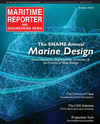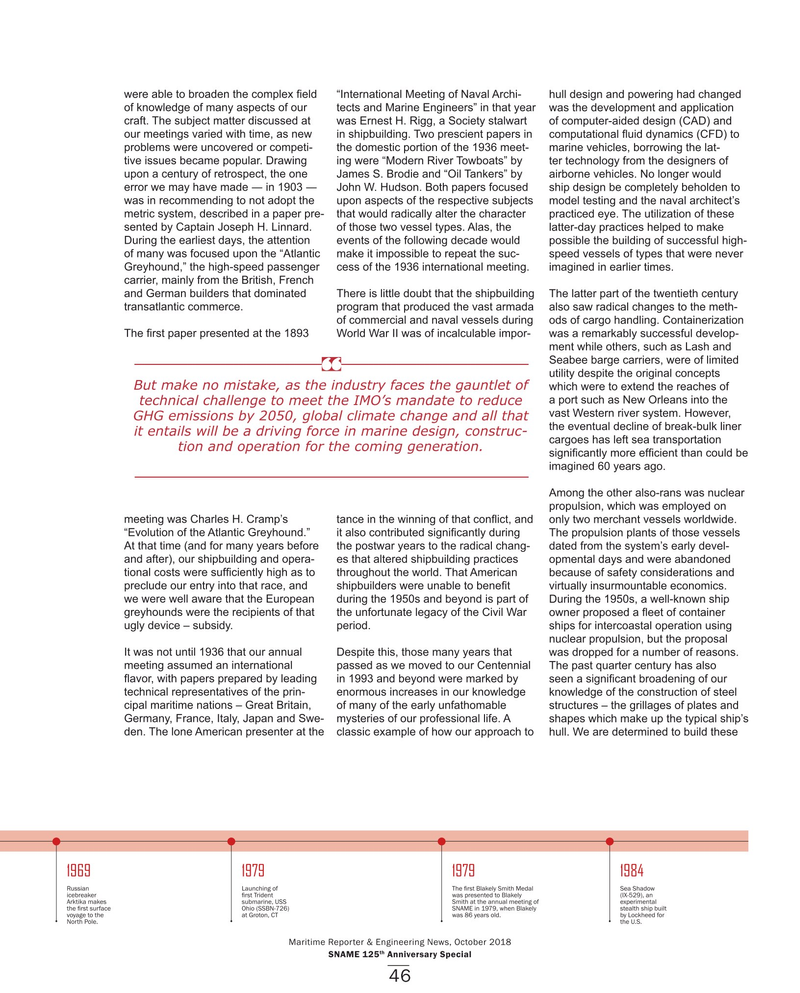
Page 46: of Maritime Reporter Magazine (October 2018)
Marine Design Annual
Read this page in Pdf, Flash or Html5 edition of October 2018 Maritime Reporter Magazine
were able to broaden the complex ? eld “International Meeting of Naval Archi- hull design and powering had changed of knowledge of many aspects of our tects and Marine Engineers” in that year was the development and application craft. The subject matter discussed at was Ernest H. Rigg, a Society stalwart of computer-aided design (CAD) and our meetings varied with time, as new in shipbuilding. Two prescient papers in computational ? uid dynamics (CFD) to problems were uncovered or competi- the domestic portion of the 1936 meet- marine vehicles, borrowing the lat- tive issues became popular. Drawing ing were “Modern River Towboats” by ter technology from the designers of upon a century of retrospect, the one James S. Brodie and “Oil Tankers” by airborne vehicles. No longer would error we may have made ? in 1903 ? John W. Hudson. Both papers focused ship design be completely beholden to was in recommending to not adopt the upon aspects of the respective subjects model testing and the naval architect’s metric system, described in a paper pre- that would radically alter the character practiced eye. The utilization of these sented by Captain Joseph H. Linnard. of those two vessel types. Alas, the latter-day practices helped to make
During the earliest days, the attention events of the following decade would possible the building of successful high- of many was focused upon the “Atlantic make it impossible to repeat the suc- speed vessels of types that were never
Greyhound,” the high-speed passenger cess of the 1936 international meeting. imagined in earlier times.
carrier, mainly from the British, French and German builders that dominated There is little doubt that the shipbuilding The latter part of the twentieth century transatlantic commerce. program that produced the vast armada also saw radical changes to the meth- of commercial and naval vessels during ods of cargo handling. Containerization
The ? rst paper presented at the 1893 World War II was of incalculable impor- was a remarkably successful develop- ment while others, such as Lash and
Seabee barge carriers, were of limited “ utility despite the original concepts
But make no mistake, as the industry faces the gauntlet of which were to extend the reaches of a port such as New Orleans into the technical challenge to meet the IMO’s mandate to reduce vast Western river system. However,
GHG emissions by 2050, global climate change and all that the eventual decline of break-bulk liner it entails will be a driving force in marine design, construc- cargoes has left sea transportation tion and operation for the coming generation. signi? cantly more ef? cient than could be imagined 60 years ago.
Among the other also-rans was nuclear propulsion, which was employed on meeting was Charles H. Cramp’s tance in the winning of that con? ict, and only two merchant vessels worldwide. “Evolution of the Atlantic Greyhound.” it also contributed signi? cantly during The propulsion plants of those vessels
At that time (and for many years before the postwar years to the radical chang- dated from the system’s early devel- and after), our shipbuilding and opera- es that altered shipbuilding practices opmental days and were abandoned tional costs were suf? ciently high as to throughout the world. That American because of safety considerations and preclude our entry into that race, and shipbuilders were unable to bene? t virtually insurmountable economics. we were well aware that the European during the 1950s and beyond is part of During the 1950s, a well-known ship greyhounds were the recipients of that the unfortunate legacy of the Civil War owner proposed a ? eet of container ugly device – subsidy. period. ships for intercoastal operation using nuclear propulsion, but the proposal
It was not until 1936 that our annual Despite this, those many years that was dropped for a number of reasons. meeting assumed an international passed as we moved to our Centennial The past quarter century has also ? avor, with papers prepared by leading in 1993 and beyond were marked by seen a signi? cant broadening of our technical representatives of the prin- enormous increases in our knowledge knowledge of the construction of steel cipal maritime nations – Great Britain, of many of the early unfathomable structures – the grillages of plates and
Germany, France, Italy, Japan and Swe- mysteries of our professional life. A shapes which make up the typical ship’s den. The lone American presenter at the classic example of how our approach to hull. We are determined to build these 1969 1979 1979 1984
Russian Launching of The ? rst Blakely Smith Medal Sea Shadow icebreaker ? rst Trident was presented to Blakely (IX-529), an
Arktika makes submarine, USS Smith at the annual meeting of experimental the ? rst surface Ohio (SSBN-726) SNAME in 1979, when Blakely stealth ship built voyage to the at Groton, CT was 86 years old. by Lockheed for
North Pole. the U.S.
Maritime Reporter & Engineering News, October 2018 th
SNAME 125 Anniversary Special 46
MR #10 (42-49).indd 46 MR #10 (42-49).indd 46 10/5/2018 10:24:43 AM10/5/2018 10:24:43 AM

 45
45

 47
47
